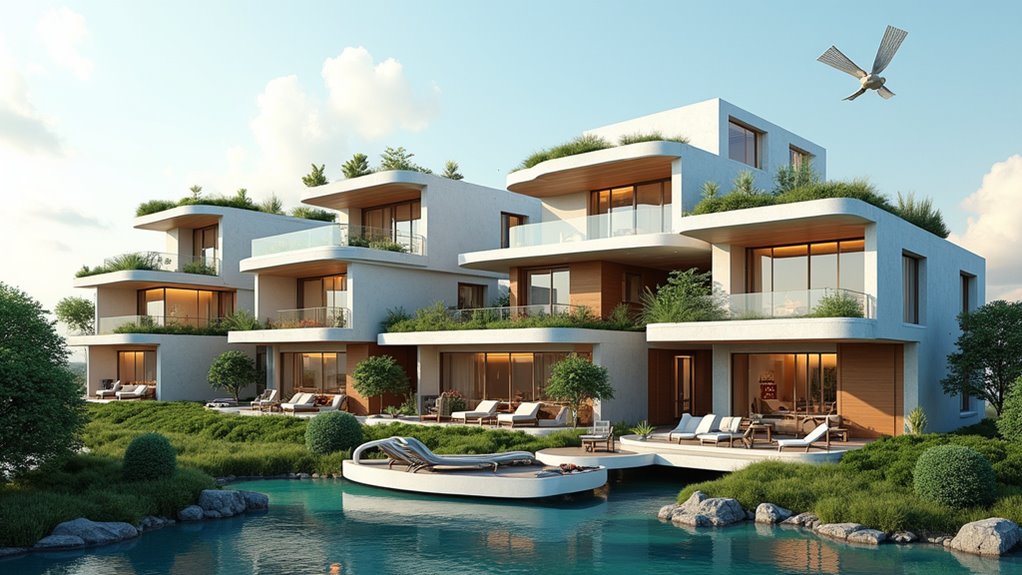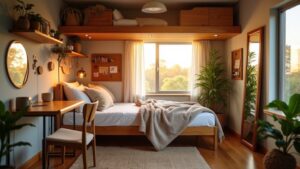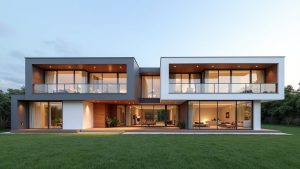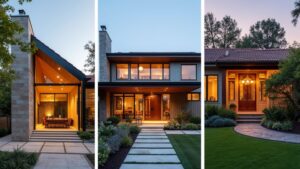In 2025, innovative new build design ideas focus on sustainability and smart technology. Homes will utilize eco-friendly materials like hempcrete and bamboo, featuring energy-efficient systems and automated appliances for enhanced living. Flexible spaces will accommodate evolving family needs, while biophilic design elements promote wellness through natural light and indoor gardens. Advanced security systems ensure peace of mind, creating safe and connected communities. A glimpse into this future reveals even more groundbreaking concepts waiting to be discovered.
Key Takeaways
- Embrace sustainable materials such as hempcrete and mycelium composites to minimize environmental impact while enhancing building durability and energy efficiency.
- Incorporate smart home automation systems to improve living comfort, energy management, and security through AI-driven technology and real-time monitoring.
- Design flexible living spaces with movable walls and multi-functional furniture to accommodate changing family dynamics and evolving lifestyle needs.
- Integrate biophilic design features like indoor gardens and large windows to maximize natural light and promote emotional well-being within residential environments.
- Foster personalized living experiences with artisanal craftsmanship and community-oriented designs that prioritize shared green spaces and resource cooperation among residents.
Sustainable and Eco-Conscious Building Practices

How can the future of architecture balance innovation with environmental responsibility? By embracing sustainable materials and eco-conscious practices, the industry is poised for transformation.
The future of architecture blends innovation with sustainability through eco-conscious practices and materials for a transformative impact.
In 2025, the use of bio-based and recycled materials such as hemp-clay composites and straw panels will dominate, reducing carbon footprints while enhancing thermal efficiency. Notably, products like EcoCocon Straw Panels achieve a GWP of -94.060 kg CO₂/m², making them an exceptional choice for sustainable construction. Additionally, the focus on reducing embodied carbon will significantly drive the selection of materials, ensuring a lower impact on the environment. The integration of bamboo as a rapidly growing and sustainable resource will emphasize natural aesthetics in modern architectural expressions. These designs may also incorporate features that foster seamless indoor-outdoor flow, allowing for fluid transitions between environments.
Innovative mycelium technology will produce biodegradable insulation and structural components, further promoting a circular economy. Additionally, the integration of advanced insulation techniques and reclaimed resources will minimize waste and resource depletion.
With aspirations for net-zero homes through energy-efficient designs, architects will not only respond to environmental challenges but also set new standards for beauty and functionality in the built environment, ensuring a sustainable legacy for future generations.
Smart Home Integration for Enhanced Living

What if the home of the future seamlessly adapts to its occupants’ needs, enhancing their daily lives through intelligent integration?
Smart home automation is at the forefront, utilizing AI-driven assistants to manage lighting, temperature, and appliances with intuitive interfaces. These systems learn habits, optimizing comfort and energy efficiency while predictive maintenance alerts homeowners to potential appliance failures. A focus on sustainable materials such as cross-laminated timber and low-VOC paints complements the technological advances for an eco-friendly approach.
Enhanced security features, like facial recognition surveillance and biometric locks, ensure safety and ease of access. Advanced connectivity, powered by robust networks and 5G technology, allows seamless interoperability among devices.
Furthermore, integration of wellness technologies—such as automated air purification and circadian lighting—promotes a healthy living environment, creating a harmonious blend of comfort, security, and efficiency in the homes of 2025. Predictive analytics support maintenance and longevity, keeping pace with various lifestyles.
Flexible Spaces for Modern Lifestyles

The future home design extends beyond smart technology, embracing flexible spaces that cater to the diverse lifestyles of its inhabitants. This evolution favors a synergy of flexible layouts and adaptable furnishings, allowing each room to transform seamlessly based on needs.
- Movable walls and sliding partitions create distinct zones for work, play, and rest.
- Multi-functional furniture, from extendable dining tables to hidden wall beds, maximizes utility within limited footprints.
- Internal courtyards enhance connectivity while separating spaces, fostering communal living without compromising privacy.
Such innovative design solutions promise homes that adapt not only to current family dynamics but also to future changes, ensuring functionality and comfort for generations to come.
Wellness and Biophilic Design Elements

In the evolving landscape of home design for 2025, wellness and biophilic elements emerge as vital components that seamlessly integrate the beauty of nature within indoor spaces.
By prioritizing natural elements such as living walls, effective air filtration systems, and abundant natural light, architects can create environments that enhance both physical well-being and emotional tranquility.
This harmonious blend of design fosters a rejuvenating atmosphere, transforming residences into sanctuaries for health and vitality.
Natural Elements Integration
While modern design often prioritizes sleek lines and minimalist aesthetics, the integration of natural elements serves as a transformative approach that enhances overall well-being and fosters a deeper connection to the environment.
Maximizing natural light through expansive windows and clever light distribution techniques not only regulates circadian rhythms but also uplifts mood and productivity.
Simultaneously, the incorporation of organic textures in materials like reclaimed wood and local stone connects inhabitants to the sensory richness of nature.
- Elevates emotional health and tranquility
- Reduces environmental impact through sustainable choices
- Enhances daily living with seamless indoor-outdoor transitions
As homes evolve towards a more biophilic design ethos, these natural elements become essential in cultivating spaces that resonate with the essence of nature.
Indoor Air Quality
As urban living continues to expand, the importance of indoor air quality (IAQ) emerges as a pivotal component of modern home design, intertwining wellness with biophilic principles.
The integration of advanced ventilation systems, such as Mechanical Ventilation with Heat Recovery (MVHR), ensures a constant influx of fresh air while trapping indoor pollutants within meticulous energy frameworks.
Smart IAQ monitoring further enhances this landscape, using AI-powered analyses to tailor air quality responses based on real-time data.
Complementing these technologies, low-VOC and natural materials contribute to healthier living spaces.
Biophilic design incorporates air-purifying plants and living walls, blurring boundaries between nature and the home, thereby promoting an environment rich in clean air and vitality, essential for 2025’s innovative builds.
Light and Space
Emphasizing the harmonious interplay of light and space, contemporary design principles prioritize wellness and biophilic elements, transforming living environments into sanctuaries of comfort and connection.
Maximizing natural light and creating open spaces fosters a positive atmosphere, enhancing the overall well-being of occupants.
- Strategic window placements invite sunlight year-round, enriching interior perspectives.
- Expansive floor plans promote fluid movement between rooms, celebrating the warmth of daylight.
- Biophilic touches, such as living walls and natural materials, deepen the bond with nature, invigorating life within.
The integration of these elements cultivates serene spaces that not only reflect beauty but nourish the spirit, turning homes into cherished retreats that embrace the essentials of modern living in 2025 and beyond.
Innovative Materials for Durability and Sustainability

Innovative materials are transforming the landscape of construction, propelling the industry towards greater durability and sustainability. Bio-based options like bamboo and cross-laminated timber exemplify eco-friendly formulations with remarkable strength and minimal environmental impact.
Innovative materials are revolutionizing construction, enhancing durability and sustainability through eco-friendly solutions like bamboo and cross-laminated timber.
Hempcrete offers lightweight thermal insulation while mycelium composites prioritize biodegradability. Straw-based materials enhance thermal efficiency and carbon sequestration, further enriching the material lifecycle.
Recycled and upcycled alternatives, including steel, concrete, and plastic panels, reduce waste and conserve resources—marking a shift towards circular construction practices.
Advanced innovations like self-healing concrete and Ferrock signify strides towards longevity, reducing maintenance needs and lowering carbon footprints.
Together, these materials redefine contemporary building, ensuring resilience without compromising ecological responsibility.
Personalized Features for Unique Living Experiences

While the future of home design embraces individuality, the integration of personalized features transforms living spaces into reflections of their inhabitants’ unique lifestyles and preferences.
Customized features are becoming essential, allowing residents to create unique experiences that enhance daily living. These innovations facilitate personal well-being and adaptability.
- Advanced AI systems autonomously adjust lighting and climate for optimal comfort.
- Flexible multi-functional spaces cater to diverse needs, from home offices to wellness retreats.
- Artisanal craftsmanship and bespoke interiors narrate the homeowner’s story.
Energy Efficiency and Renewable Energy Solutions

As the architecture of tomorrow unfolds, the concept of net-zero energy homes emerges as a beacon of sustainability, embodying innovation and environmental stewardship.
Smart renewable energy systems harmonize seamlessly within these structures, intelligently managing resources to maximize efficiency while minimizing waste.
Embracing technologies like solar integration and energy storage, these futuristic dwellings redefine the boundaries of eco-friendly living and pave the way for a greener future.
Net-Zero Energy Homes
With the world increasingly focused on sustainability, net-zero energy homes emerge as a forward-thinking solution blending energy efficiency with renewable energy sources.
These dwellings are designed with strategic energy independence strategies, emphasizing zero energy design principles that align with modern ecological values.
Key features include:
- Strategic building orientation to optimize solar gain.
- Advanced insulation and airtight construction minimizing energy loss.
- Integration of renewable systems like solar PV and geothermal energy.
Smart Renewable Energy Systems
The future of energy management is poised to be revolutionized by smart renewable energy systems, which seamlessly integrate advanced technology with sustainable practices.
Solar panel advancements, such as solar shingles and bifacial models, promise to enhance energy efficiency by up to 30%. Transparent solar panels could transform windows into energy-generating surfaces, while innovations in energy storage like solid-state and sand batteries offer efficient, long-lasting solutions.
The synergy of AI-powered home energy management systems can optimize consumption, predict maintenance needs, and reduce energy bills significantly. Coupled with emerging technologies like hydrogen fuel cells and IoT applications, these systems embody a visionary approach toward a sustainable energy future, heralding a new era of intelligent, efficient, and renewable-powered living.
Indoor-Outdoor Living Concepts

Seamless transitions between indoor and outdoor living spaces are set to redefine residential design in 2025. Homeowners will embrace features like retractable screens and expansive glass walls, blurring boundaries while inviting nature indoors.
- Indoor gardens flourish, enhancing air quality and well-being.
- Uninterrupted views and natural light evoke a tranquil atmosphere.
- Fluid spaces allow dynamic arrangements, fostering a sense of adventure.
This innovative approach highlights material and textural continuity, with consistent flooring linking areas.
Earthy palettes and organic textures enhance the connection to nature, while movable furniture enhances flexibility.
Embracing earthy palettes and organic textures fosters a deeper connection to nature while flexible furniture promotes adaptability in living spaces.
As designs shift toward biophilic ideals, these concepts will promote mindfulness, encouraging people to live harmoniously with their environment, ultimately transforming the essence of home.
Advanced Security Innovations for Peace of Mind

As the landscape of home security evolves in 2025, the integration of AI-powered surveillance systems and advanced biometric access control promises a revolutionary leap in safeguarding personal spaces.
Real-time monitoring, combined with intuitive threat recognition, empowers homeowners with unparalleled peace of mind, allowing them to respond to potential threats with immediacy and precision.
Remote monitoring solutions further enhance this security framework, ensuring that safety is always within reach, no matter where one may roam.
AI-Powered Surveillance Systems
In an era where safety is paramount, AI-powered surveillance systems emerge as the frontline guardians of modern homes. These intelligent systems enhance security through real-time threat assessment and predictive analysis, ensuring peace of mind with minimal intrusion.
- Enhanced threat detection capabilities reduce false alarms and notify users instantly.
- Behavioral learning enables proactive security measures, adapting to daily routines.
- Automated responses integrate seamlessly with smart home devices, streamlining safety protocols.
However, the conversation surrounding AI ethics, data privacy, and user trust is crucial. Transparency in surveillance and adherence to robust privacy policies are essential to mitigate algorithm bias and ensure human oversight.
As technology acceptance grows, so too must the commitment to data security, fostering a safe future for homeownership.
Biometric Access Control
The evolution of home security has reached a new frontier with the advent of biometric access control systems, revolutionizing the way homeowners safeguard their residences.
These innovative technologies leverage unique biometric advantages—like fingerprint recognition, facial analysis, and iris scanning—to create unparalleled security and convenience.
As users transition to keyless entry, they enjoy seamless access management without the need for physical keys or PIN codes. This integration not only enhances security but also fosters personalized automation, adjusting home settings to individual preferences.
Through controlled visitor access and centralized management, these systems ensure that homeowners maintain oversight while boosting property value.
The fusion of biometrics with smart home ecosystems signals a future where advanced security aligns with daily living.
Remote Monitoring Solutions
While homeowners increasingly seek peace of mind in an ever-evolving security landscape, remote monitoring solutions emerge as pivotal innovations redefining safety standards.
Harnessing AI analytics, these systems learn and adapt, distinguishing genuine threats from benign activities.
- Real-time access to security footage ensures vigilance, regardless of location.
- Advanced sensors detect anomalies, providing proactive alerts for unusual behaviors.
- Automated responses integrate seamlessly with smart home systems, escalating alerts when risks arise.
Future-Proofing Designs for Evolving Needs

As lifestyles evolve and the concept of home transforms, future-proofing house designs has become essential for accommodating diverse needs. Innovative designs now prioritize adaptable infrastructure that supports co-living solutions and multifunctional spaces.
Flexible layouts enable reconfiguration for varying furniture arrangements, while multi-purpose rooms can transition seamlessly to meet family dynamics—transforming a nursery into a study, for instance.
Modular designs, featuring sliding walls and retractable furniture, maximize urban space efficiency. Moreover, homes are pre-wired for advanced technology integration, enabling easy upgrades and smart management of energy systems.
Intentional planning for future expansion ensures structural readiness for life changes, making these living spaces resilient and aligned with contemporary living norms, ultimately fostering sustainability and community.






